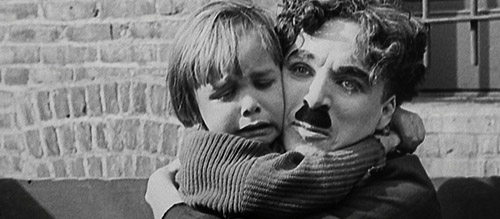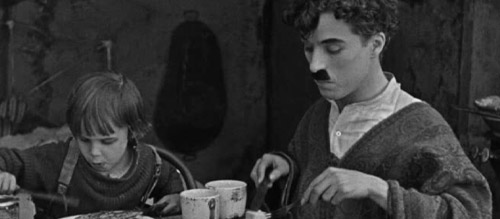Chaplin’s ‘The Kid’ – 100 Year Anniversary Review
The Kid (1921)
Director: Charlie Chaplin
Screenwriter: Charlie Chaplin
Starring: Charlie Chaplin, Jackie Coogan, Edna Purviance, Carl Miller, Walter Lynch
Inequality, wealth disparity, gendered oppression and prejudice have long been among the thematic building blocks of great cinema, but rarely have they been presented with such innocence as in a Charlie Chaplin motion picture, and perhaps never have we seen all of them presented at once with such a cheekiness as in Chaplin’s seminal feature The Kid, released 100 years ago in 1921.
Charles Chaplin, then credited as Charlie Chaplin, was one of Hollywood’s great early filmmakers; a worldwide megastar known for his character The Tramp – a short moustachioed man with baggy clothes and clown-like shoes pointed in either direction of his body. Through slapstick humour, the films of Chaplin translated to audiences across the world, the timeless messages of love and equality easily recognisable no matter the culture – and in a decade that would come to be dominated by his pictures, the great writer, director, producer, composer and performer would start as he would mean to go on, 1921’s The Kid being one of the most influential and certainly one of the decade’s most timeless offerings.
Telling the tale of The Tramp – Chaplin’s iconic silver screen character who would be the focus of each of his pictures for 20 years – and a child he finds in the trash and chooses to take in after reading a note from its beleaguered mother buried in its clothing, The Kid visits so many of the great filmmaker’s most iconic themes and ideologies, ultimately pitting the down-on-their-luck unlikely duo against the oppressive forces of the police, the government and the always looming threat of malnutrition and disease caused by the duo’s complete absence of wealth; all the while cheekily breaking the fourth wall and causing many a smile through its slapstick antics.
The Kid opens with the title card “The woman – whose sin was motherhood”, and it is clear when viewing the piece with the knowledge that Chaplin was a child of the workhouse and his mother was placed in an “Insane Asylum” for raising him outside of marriage, that this opening title card was a targeted point made in opposition to the way governments and wider society ousted single mothers and their children into obscurity. Chaplin was a child born of oppression and poverty, and upon his arrival in the United States paid for his mother to be moved there with him to live in luxury for the rest of her life, and in The Kid it is clear this experience is central to the great filmmaker’s belief system and to the characters he creates. The woman in question, simply named The Woman and played by Edna Purviance, is alone and unable to feed her child when she comes across the car of a family of aristocrats and chooses to leave her baby there in the hopes of a better life for it. The car is then stolen by lowly criminals and the child put in the trash to be found by Chaplin’s Tramp, the narrative following the story of The Tramp and The Kid adjacent to that of The Woman, as The Woman is given a second chance at life, becoming famous and achieving all the things that the people of the time would never dare believe but Chaplin made integral to his story nonetheless.
The Kid’s politically motivated narrative is melted onto the structure of a superb stage comedy, the silent antics of Chaplin’s Tramp and Jackie Coogan’s The Kid rushing through frame, the characters playfully looking into the camera to evoke empathy or laughs when the time calls. Entire sequences are structured as jokes, with Chaplin placing us in the position of the all-seeing eye, awaiting the disaster that is coming to The Tramp unbeknownst to him. We laugh in anticipation of the silliness, and Chaplin strings it out for all it’s worth; then we laugh as the anticipated tension comes and is so gleefully performed, Chaplin never failing to seem as if he is enjoying himself. It makes for a joyous experience, and one that you can’t take your eyes off; what’s even more remarkable is how Chaplin isn’t done – he forces us to laugh again as he subverts expectations or offers a second laugh he’d set up earlier on but we’d probably forgotten about. It’s writing that can be described as nothing other than genius, and the performances are worthy of Chaplin’s great reputation as both an actor and director, every part played with a similar glint in the eye and physical gusto as the great man himself.
Yet, as with all great filmmakers, the narrative and the performances are just one factor to consider when judging a famous piece, Chaplin’s remarkable creativity behind the camera being somewhat revolutionary for the time. The film features a third act dream sequence that is bookended by soft fades in which Chaplin’s Tramp goes to heaven, goes shopping for wings, flies up and down the set, and is reunited with his son, only to be shaken awake on the doorstep of the house he’s no longer able to stay in. It’s a moment that evokes contemporary comparisons to the likes of Parasite and La La Land, each of which were inspired by films which were inspired by other films which were ultimately inspired by The Kid – and there’s no greater tribute to Chaplin’s work than this. Furthermore, late in the second act, The Woman looks directly into the camera to indicate to us that she is reminiscing on her time with her newborn baby – a distinct moment of juxtaposition to the cheeky smiles and looks of acknowledgement that have permeated Chaplin’s use of the technique to that point – while title cards and iris fades are regular occurrences that clue us in to the passing of time and the development of perspectives, illustrating Chaplin’s desire to further film language and make it as central to his storytelling as any other aspect. Chaplin was by no means the first to include such techniques in a feature film, but he was certainly an early purveyor, and was as talented as anyone at making them a part of his storytelling. During a time when the form was still brand new, Chaplin seemed to be from another world, his combination of the best of cinematic storytelling, narrative storytelling and performative storytelling being truly awe-inspiring.
In The Kid, humanity isn’t bad, but the constructs of society are – the absurd orphanage system and the people who uphold it without empathy or even humanity, the police who uphold the norms of an oppressive system through violence, toxic masculinity that pits those at the bottom against one another for scraps, the monetary disparity that causes thievery and starvation, the sexist agenda that sees women locked up for falling pregnant outside of wedlock yet has men continue as normal. It’s a stance Chaplin would take for the rest of his career – an ideological perspective that would have him chased from the United States for being a suspected communist – and so much of it remains so sadly relevant to our contemporary space. After a century of war, protests, technological advancements and political evolution, The Kid is just as necessary and just as important as it was at the beginning of the 20th century; an unmissable film not only to cinephiles and film aficionados, but a gently thought-stirring 53 minutes of cinema that is guaranteed to bring a smile to your face.
24/24



